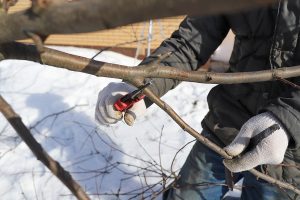 Although every tree has its own set of requirements for optimal growth, most benefit from proactive tree care in winter. During their dormancy in the cold-weather months, pruning can be used to ensure trees experience active growth come springtime. Removing dead or unhealthy branches and encroaching limbs can pave the way for more lively greenery or increase your fruit harvest. However, you must go about maintenance in the right way to achieve success. Let’s review some tips for pruning trees in winter.
Although every tree has its own set of requirements for optimal growth, most benefit from proactive tree care in winter. During their dormancy in the cold-weather months, pruning can be used to ensure trees experience active growth come springtime. Removing dead or unhealthy branches and encroaching limbs can pave the way for more lively greenery or increase your fruit harvest. However, you must go about maintenance in the right way to achieve success. Let’s review some tips for pruning trees in winter.
When is the Right Time to Prune Trees in Winter?
Once the leaves have fallen and the tree’s branches become exposed, it’s far easier to prune. This allows you to observe its growth and spot areas of concern, such as diseased or dead branches and limbs extending above your home or neighbor’s property. While many fruit, coniferous, and other types of trees respond well to pruning throughout winter, you should be much warier of sap-producing trees, such as maple, elm, walnut, and birch. For these types of trees, it’s best to wait until late summer or early fall, as cutting them in winter can cause seepage, potentially leading to bacterial disease.
Tips for Winter Tree Pruning
You’ll need a variety of gardening tools, including a hand pruner, loppers, a handsaw, shears, and protective eyewear. Start by removing smaller branches first, using your hand pruners to make a diagonal cut a quarter-inch above where it parts from the main branch – the “shoulder.” However, when it comes to larger branches, you should do the following:
- Meet Your Cuts in the Middle: Cut halfway up the limb from the bottom, and then complete the cut by meeting it in the middle from the top. This will prevent the branch from falling prematurely and stripping the tree of bark.
- Cut in Stages: Removing a large limb in three or more cuts will prevent damage to yourself and the tree.
- Make a 45 Degree Cut: Cut the branch at the shoulder at a 45-degree angle. This prevents water damage and bacterial disease and guides the direction of future growth.
Not only will winter maintenance discourage pest damage and diseases in spring and summer, but it also frees up time for other projects during the warm-weather months.
If you follow these tips for tree pruning in winter, you’ll witness great tree health and growth come spring. However, it’s important to know your limits when pruning. If the job is well outside your experience, you should hire a professional, like Dolan Landscaping. We can help with everything from landscape maintenance to snow removal this season. If you need the help of a professional tree pruner, contact us today.